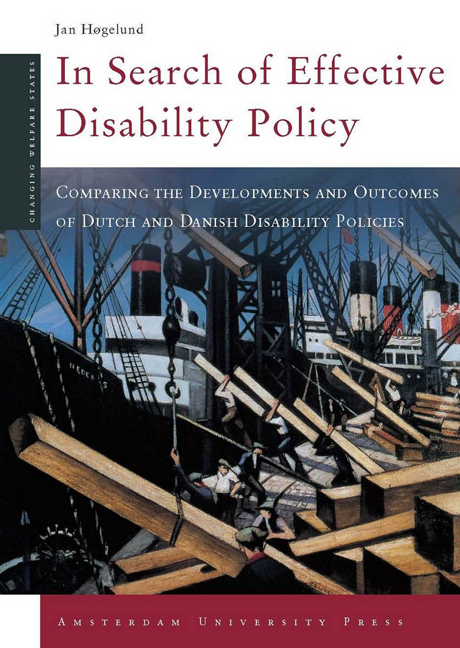 In Search of Effective Disability Policy
In Search of Effective Disability Policy Book contents
- Frontmatter
- Contents
- Acknowledgement
- 1 Disability Policies Under Pressure
- 2 The Integration of Disabled People:What Do We Know?
- 3 Bringing the Pieces Together:A Multidisciplinary Approach to Work Disability
- 4 Economic Miracles Bypassing Disabled People
- 5 Dutch Disability Reforms:Redefining Responsibilities
- 6 Danish Disability Policy:Small Steps,Big Change?
- 7 Different Routes to Integration
- 8 Different Policies – Different Outcomes
- 9 Too Much and Too Little:Employers’Responsibility in Denmark and the Netherlands
- Tables and Figures
- Notes
- References
- Index of Subjects
- Index of Names
3 - Bringing the Pieces Together:A Multidisciplinary Approach to Work Disability
Published online by Cambridge University Press: 15 January 2021
- Frontmatter
- Contents
- Acknowledgement
- 1 Disability Policies Under Pressure
- 2 The Integration of Disabled People:What Do We Know?
- 3 Bringing the Pieces Together:A Multidisciplinary Approach to Work Disability
- 4 Economic Miracles Bypassing Disabled People
- 5 Dutch Disability Reforms:Redefining Responsibilities
- 6 Danish Disability Policy:Small Steps,Big Change?
- 7 Different Routes to Integration
- 8 Different Policies – Different Outcomes
- 9 Too Much and Too Little:Employers’Responsibility in Denmark and the Netherlands
- Tables and Figures
- Notes
- References
- Index of Subjects
- Index of Names
Summary
This chapter seeks to bring together the different insights of the clinical, economical, public policy and sociological approaches to work disability. This should help to improve our understanding of how conditions both at the individual level and at a structural level influence the labour market attachment of disabled people. That is, how do disabled people's individual characteristics and family relations lead to different outcomes? How do labour market conditions affect the labour market situation of work-disabled people? Which policy instruments may be of importance, and how do they interact with individual characteristics to produce diverse labour market outcomes?
Choosing the approach
Why do some individuals with health problems remain firmly attached to the labour market whilst of working age while others remain non-working for most or all of their adult years? In order to develop a framework that can shed light on this question, several issues and choices have to be dealt with. One issue concerns the type of model we should construct. What types of explanatory factors should be included? How should they be allowed to interact? And how should we define the outcome, ‘labour market attachment’?
The literature review revealed that each of the four theoretical disciplines, the medical, economical, public policy, and sociological, may contribute to explain why the labour market attachment of people with health problems differs. The review also showed that studies in this field integrate insights and variables from other approaches only to a limited degree. This may lead to erroneous conclusions as important variables are omitted from the analysis. We should therefore demand that a labour market attachment model is eclectic; it should integrate insights from the four different research approaches by regarding them as complementary rather than competing.
The analytical level applied in the different theoretical disciplines differs. Whereas medical and economic studies concentrate on the importance of individual level factors such as health status and replacement rates, public policy studies focus on the importance of macro-level conditions such as policy instruments. A comprehensive model must reflect variables at both levels. I will assume that macro-level conditions either directly or through various actors affect disabled individuals, which in turn determines their labour market attachment (this approach is called methodological individualism, see Elster, 1985 and Colbjornsen, 1986).
- Type
- Chapter
- Information
- In Search of Effective Disability PolicyComparing the Developments and Outcomes of the Dutch and Danish Disability Policies, pp. 53 - 64Publisher: Amsterdam University PressPrint publication year: 2003


